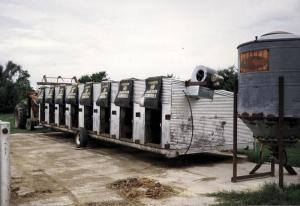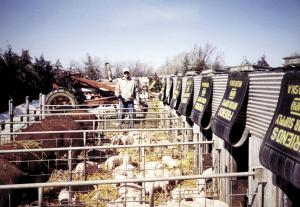2002 - Volume #26, Issue #6, Page #10
[ Sample Stories From This Issue | List of All Stories In This Issue | Print this story
| Read this issue]
"Low Labor" Portable Farrowing Building
 |
 |
 |
Hinrikus found a profitable way to eliminate the hard labor associated with bedded pens without losing any of the benefits. "We would never go back to crates," he says.
What he did was to design 8-stall portable farrowing houses that he can pick up and move after the pigs are weaned and moved out. Then it's a simple matter of using a tractor to scrape down the cement pad the houses sit on and power washing the farrowing house.
"They're built on frames made from used center pivot irrigation pipe," he explains. "We pick up one end with a tractor and loader, back a trailer underneath and pull it out of the way."
Once each house is freshly bedded and back in place, the next set of sows is welcomed to their maternity ward. Pigs are happier, reports Hinrikus, and so is he.
"It takes my dad and I about one third the time to clean these sheds as it did to power wash crates. With the straw, you don't get the odors. The pigs are easier to work, and you don't stink after being around them," he notes.
Hinrikus has built three modular farrowing houses with his father. Each building contains eight 4 by 8-ft. stalls with front and back entrances. Each building is 5 ft. high at the front entrance and 3 1/2 ft. high at the rear. The combination of reduced head space and insulation sprayed on walls and ceilings keeps the pens warm in Nebraska winters. A squirrel cage fan and ductwork attached to each pen, combined with the ability to open front and rear entrances for air movement, keeps pigs cool in the summer. Each house is wired for heat lamps at farrowing.
Mud flaps on front serve as barriers against the wind while allowing the pigs easy entrance and exit, while the back door allows Hinrikus access to the baby pigs and makes adding straw simple. Each pen opens to a 4 by 12-ft. outside pen, also positioned over the concrete pad. This area serves as an exercise space and is used for twice-a-day floor feeding. The waterer is out there, too. Pigs can be easily locked inside when the outside pad needs to be scraped clean.
After two to three weeks in the farrowing house, sows and their approximately 50 piglets are grouped in a larger pen for three to four weeks before the pigs are weaned. At 2 1/2 months, the pigs are split into groups of 25 according to size and moved back onto cement and into 8 by 32-ft. sheds. They are deep bedded with bean straw until marketed at 250 lbs. These sheds and outside pens are also designed for low labor, allowing a tractor access for quick cleaning as needed.
Deep bedding throughout their lives, plenty of room for exercise, and a medication-free feeding program qualifies his pigs for marketing through Nimann Ranch. The specialty meat seller offers a base floor of $40/cwt. with a minimum premium above the cash market when it rises above the base. In addition, Hinrikus receives added premiums because of his year-round farrowing. Most suppliers to Nimann Ranch farrow in spring and fall, but he farrows his 100 sows year śround, keeping around 700 pigs in finishing houses at any one time.
"We have to meet the protocols on animal husbandry," says Hinrikus. "We can vaccinate, but if we use antibiotics we can't sell through Nimann. "We have better herd health than ever, and when we do have to treat, the antibiotics work."
Contact: FARM SHOW Followup, James Hinrikus, 13251 S. 90 Rd., Prosser, Neb. 68883 (ph 402 744-2075).

Click here to download page story appeared in.

Click here to read entire issue
To read the rest of this story, download this issue below or click here to register with your account number.




